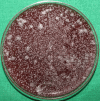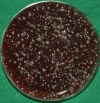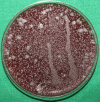Efficacy of Oxygen-Enriched Mouthwash as a Pre-procedural Mouth Rinse Against Oral Microbes Produced During Ultrasonic Scaling
- PMID: 38130543
- PMCID: PMC10733898
- DOI: 10.7759/cureus.49164
Efficacy of Oxygen-Enriched Mouthwash as a Pre-procedural Mouth Rinse Against Oral Microbes Produced During Ultrasonic Scaling
Abstract
Aim Oxygen-enriched mouthwash products are based on oral topical oxygen therapy (OOT), which supports the formation of new blood vessels and the removal of toxins and waste products from the affected area and stimulates the synthesis of collagen. These antioxidant mouthwashes contain honey, lactoferrin, and sodium carbonate peroxide. Lactoferrin is an anti-inflammatory protein that binds the ferrous iron ions surrounding micro-organisms regulating bacterial growth. Hence, these products can be included as an adjunct to toothbrushing after oral surgeries and in the treatment of conditions like gingival inflammation and peri-implantitis. The aim of the study was to evaluate the efficacy of oxygen-enriched mouthwash as a pre-procedural mouth rinse against oral microbes in the aerosol produced during ultrasonic scaling. Materials and methods A total of 40 patients with an age range of 20-40 years who have been advised to undergo ultrasonic scaling were selected as study subjects and were randomly allocated to group 1 (test group; n = 20; blue®m mouthwash) and group 2 (control group; n = 20; chlorhexidine). After evaluating the initial bacterial load after the use of water (placebo) as pre-rinse on the patient's chest and shoulder areas in both experimental and control groups, both the group subjects were instructed to gargle with 10 ml of the provided mouth rinse for one minute before ultrasonic scaling procedure. Blood agar plates were placed at the patient's chest and shoulder area to collect the aerosol and were later incubated to assess the colony-forming units (CFUs). An independent t-test was done to compare the CFUs between the groups. Results The mean initial bacterial load after the use of water (placebo) as pre-rinse on the patients' chest area (122.4 ± 0.6) and shoulder area (109.3 ± 2.6) in the experimental group was similar to the bacterial load seen on the chest area (126.2 ± 4.8) and shoulder area (115.4 ± 3.8) in the control group. The CFUs found in blood agar plates placed on the chest (59.8 ± 2.5) and shoulder (35.3 ± 3.6) areas of patients in group 1 were less as compared to CFUs found in blood agar plates placed on the chest (104.8 ± 3.2) and shoulder (75.3 ± 2.8) areas of patients in group 2. The difference between both groups was statistically significant with a p-value of ≤0.05. Conclusion There is a reduction in the bacterial load in the aerosols that are emitted during the ultrasonic scaling procedure with the use of oxygen-enriched mouthwash as a pre-procedural rinse when compared with chlorhexidine.
Keywords: aerosol contamination; blue m; chlorhexidine gluconate mouthwash; infection prevention and control; pre-procedural rinse.
Copyright © 2023, Sindhusha et al.
Conflict of interest statement
The authors have declared that no competing interests exist.
Figures









Similar articles
-
Efficacy of preprocedural mouth rinsing in reducing aerosol contamination produced by ultrasonic scaler: a pilot study.J Periodontol. 2014 Apr;85(4):562-8. doi: 10.1902/jop.2013.120616. Epub 2013 Jul 15. J Periodontol. 2014. PMID: 23855840 Clinical Trial.
-
Effects of preprocedural mouth rinse on microbial load in aerosols produced during the ultrasonic scaling: A randomized controlled trial.J Indian Soc Periodontol. 2022 Sep-Oct;26(5):478-484. doi: 10.4103/jisp.jisp_281_21. Epub 2022 Sep 1. J Indian Soc Periodontol. 2022. PMID: 36339387 Free PMC article.
-
Efficacy of Preprocedural Boric Acid Mouthrinse in Reducing Viable Bacteria in Dental Aerosols Produced during Ultrasonic Scaling.Contemp Clin Dent. 2021 Jul-Sep;12(3):282-288. doi: 10.4103/ccd.ccd_374_20. Epub 2021 Sep 21. Contemp Clin Dent. 2021. PMID: 34759686 Free PMC article.
-
Interventions to reduce contaminated aerosols produced during dental procedures for preventing infectious diseases.Cochrane Database Syst Rev. 2020 Oct 12;10(10):CD013686. doi: 10.1002/14651858.CD013686.pub2. Cochrane Database Syst Rev. 2020. PMID: 33047816 Free PMC article.
-
Pre-procedural Antimicrobial Mouth Rinse: A Concise Review.Cureus. 2022 Oct 24;14(10):e30629. doi: 10.7759/cureus.30629. eCollection 2022 Oct. Cureus. 2022. PMID: 36426310 Free PMC article. Review.
Cited by
-
Local Oxygen-Based Therapy (blue®m) for Treatment of Peri-Implant Disease: Clinical Case Presentation and Review of Literature about Conventional Local Adjunct Therapies.Medicina (Kaunas). 2024 Mar 8;60(3):447. doi: 10.3390/medicina60030447. Medicina (Kaunas). 2024. PMID: 38541173 Free PMC article. Review.
-
Lactoferrin Solution as a New Natural Photosensitizer in Photodynamic Therapy Against Oral Candida spp. Multidrug-Resistant Isolates: A Preliminary In Vitro Study.Microorganisms. 2025 May 29;13(6):1255. doi: 10.3390/microorganisms13061255. Microorganisms. 2025. PMID: 40572142 Free PMC article.
References
-
- Hinds WC, Zhu Y. New York, NY: John Wiley & Sons; 2012. Aerosol Technology: Properties, Behavior, and Measurement of Airborne Particles.
-
- Aerosol and splatter contamination from the operative site during ultrasonic scaling. Harrel SK, Barnes JB, Rivera-Hidalgo F. J Am Dent Assoc. 1998;129:1241–1249. - PubMed
-
- Cottone JA, Terezhalmy GT, Molinari JA. Baltimore, MD: Lippincott Williams & Wilkins; 1996. Cottone's Practical Infection Control in Dentistry.
-
- Comparative evaluation of efficacy of chlorhexidine and herbal mouthwash as a preprocedural rinse in reducing dental aerosols: a microbiological study. Nayak SU, Kumari A, Rajendran V, Singh VP, Hegde A, Pai KK. Int J Dent. 2020;2020:2021082.
LinkOut - more resources
Full Text Sources
